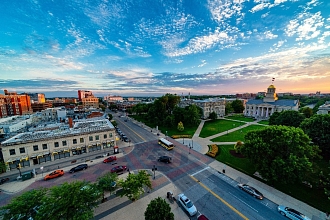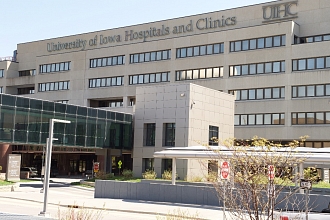University of Iowa – Carver College of Medicine
Iowa City, United States of America
Foot and Ankle Division
Fellowship Director: Cesar de Cesar Netto, MD, PhD
Our department has a history worthy of celebration. Since 1913 when John Bowman, the ninth President of the University of Iowa, appointed Arthur Steindler as Instructor in Orthopedic Surgery, the University of Iowa Department of Orthopedics and Rehabilitation has become an internationally recognized preeminent clinical, educational and research program. This success is due to the education and talent of generations of faculty, residents, staff and alumni of the residency program and the medical school.
Over the last 100 years, Iowa Orthopedics has helped advance the entire specialty of orthopedics. The Department’s studies of the cell, molecular and matrix biology of bone, cartilage, growth plate, tendon and ligament and intervertebral disc and the injuries and diseases that affect these tissues have led to many of the most important developments in musculoskeletal research. This work continues in the Ponseti Biology Laboratory and the Spine and Bone Healing Laboratory. The University of Iowa Orthopedic Biomechanics Laboratory has been a world leader in advancing understanding of the mechanics of the musculoskeletal system, the invention of new joint replacements and methods of fracture fixation and innovative approaches to measuring the wear of joint replacements and the mechanical forces that cause osteoarthritis. Clinical research based in the Department has helped guide improvements in the treatment of patients with fractures and joint injuries, severe arthritis that requires joint replacements and skeletal deformities including congenital hand deformities, clubfoot, scoliosis, and hip dysplasia.
The Department’s teaching programs have educated generations of medical students and orthopedic residents, and many former Iowa Orthopedic residents have become leaders in Orthopedic surgery. The Department’s nationally recognized residency program attracts the best medical students from schools throughout the United States. Faculty have earned national and international recognition for their clinical expertise, research, and regional, national, and international leadership positions, and participation in groups dedicated to improving national health policy. Four faculty have served as president of the world’s largest Orthopedic society, the American Academy of Orthopedic Surgeons, four faculty have served as president of the world’s oldest Orthopedic society, the American Orthopedic Association, six faculty have served as president of the Orthopedic Research Society and six faculty have served as directors of the American Board of Orthopedic Surgery – an exceptional record of leadership and accomplishment.
The department has a nationally acclaimed residency program which brings recognition to UI Healthcare and helps attract and retain talented faculty and develops future academic leaders. The best resident candidates come to Iowa to train with outstanding faculty. We have strong research labs. We are rated # 11 in NIH funding among orthopedic departments and as recently as 2010 we were # 1. Our three labs work well together, and all participate in our p-60 CORT Grant. Our labs also work well with the clinical faculty. This has been a clear strength of our research enterprise and leads to basic research that easily translates into clinical care.
The most important department resource is our faculty. They provide outstanding care to our patients, educate medical students and residents, direct research programs and project our reputation for excellence by becoming local and national leaders. We have senior faculty that are among the most renowned orthopedic surgeons in the nation. We have junior faculty who have the talent and drive required to become the next generation of national leaders and we must maximally support their career development. The department needs to provide the junior faculty unparalleled career development opportunities through mentorship and access to outstanding research and educational resources. Several of our current residents have tremendous, almost unique, academic potential. They need to be recruited to our faculty and mentored to contribute to our mission. These young faculty members will lead the department into the middle of our second century of excellence. Most importantly, we must foster a culture where all faculty members, at all career stages, embrace a vision of teamwork, collaboration, and commitment to excellence. In the future our strength will be with the young faculty members that will carry the tradition of Iowa orthopedics. With new faculty that we will recruit in critical areas, we will be set to fulfill our mission and strategic plan and remain one of the great departments in the world over at least the next 25 years.
The department's facilities include 48 orthopedic beds, ten outpatient clinics, inpatient and outpatient operating rooms, a specialty library, a specialty radiology unit, and physical therapy and rehabilitation facilities. Its specialty clinics deal with virtually every orthopedic disorder known, including, but not limited to scoliosis, clubfeet, congenital dislocated hip, neuromuscular disease, metabolic disease, amputation, neoplasm, trauma, and neck, back, hip, foot, knee, and hand problems. Physicians in the outpatient clinic see approximately 300 patients per day, over 80,000 patients per year and approximately 9,000 surgeries are performed each year.
Mission Statement
Improve the lives of people suffering from disease, deformities and injuries of the spine and limbs.
Goals
- Provide exemplary, compassionate, and effective patient care.
- Critically evaluate the initial and long-term results of medical, surgical, and physical treatments
- Develop more effective medical, surgical, and physical treatments and ways of preventing diseases and injuries.
- Advance knowledge of the structure, function, diseases, injuries and restoration of the limbs and spine and the tissues, cells and molecules that form them.
- Teach medical, graduate, and undergraduate students, resident physicians and practicing physicians the structure, function, and pathophysiology of the musculoskeletal system the values, ethics and methods of the arts and sciences of orthopedics and rehabilitation.
Contact:
Fellowship Director:
Cesar de Cesar Netto, MD, PhD
Assistant Professor
200 Hawkins Dr, John PappaJohn Pavillion (JPP)
Iowa City, 52242
Phone: (+1)(443)9259494
cesar-netto@uiowa.edu
IBRA Administration Office
Hochbergerstrasse 60E
CH-4057 Basel, Switzerland
© 2019 IBRA
IBRA Newsletter
IBRA Administration Office | Hochbergerstrasse 60E | CH-4057 Basel, Switzerland | Phone: +41 (0)61 319 05 05 | info@ibra.ch | www.ibra.ch




